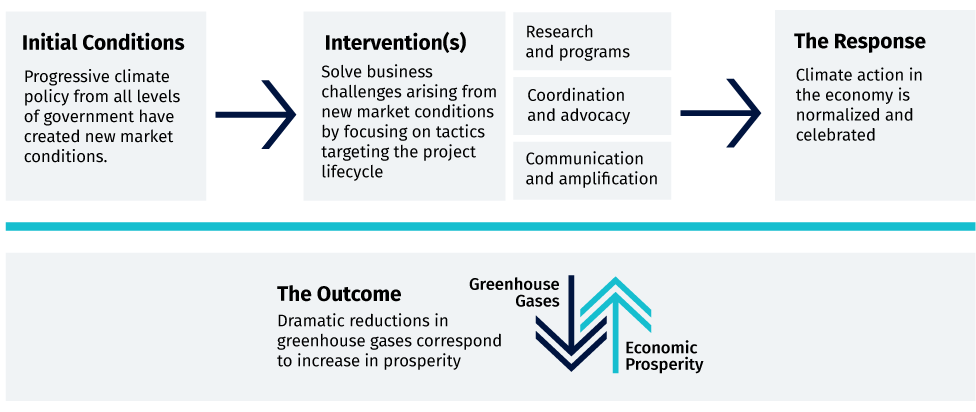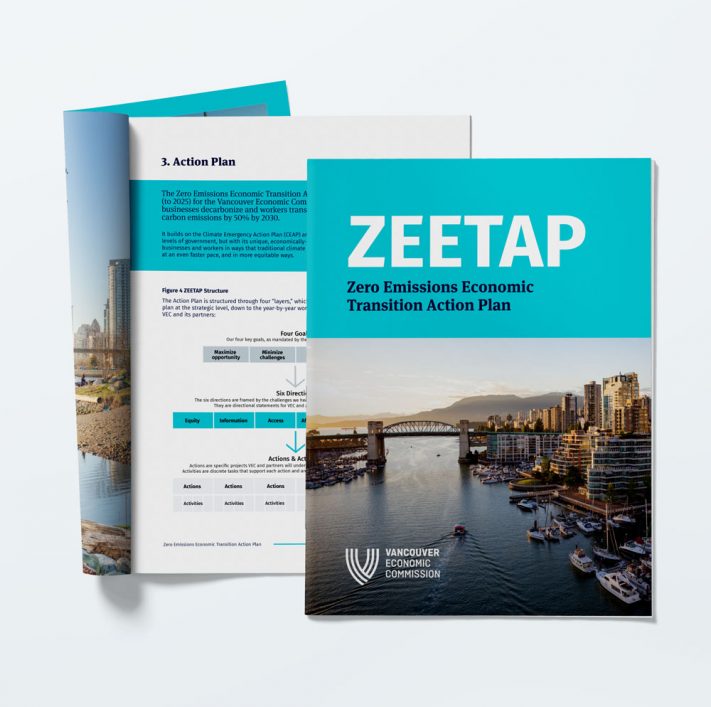What is ZEETAP?
Vancouver’s economy is at a turning point: we can double-down on a just and equitable zero-carbon future, or we can let the world race ahead. The choice is ours.
The Vancouver Economic Commission (VEC) has been at the forefront of the green economy for over a decade. Through an inaugural green jobs count in 2011, VEC broke new ground to understand and help encourage the prosperous transition to a net zero economy.
In November 2020, the City of Vancouver approved the Climate Emergency Action Plan (CEAP), which declared the necessity of speeding up climate action in recognition of the IPCC’s warnings about warming above 2°C.
When Vancouver City Council approved the Climate Emergency Action Plan, they also directed VEC to develop a complementary one that addresses prospective economic opportunities and challenges triggered by the big moves in CEAP and by the climate emergency itself.
In response to this directive, VEC applied its expertise in the green economy, research and industry engagement to develop the first climate emergency plan of its kind. ZEETAP distinguishes itself by being written by an economic developer focusing on the economic transition, and taking into account the relatively limited powers of a municipality.
The Zero Emissions Economic Transition Action Plan (ZEETAP) supports the City of Vancouver’s ambition to halve greenhouse gas (GHG) emissions by 2030, while integrating four economic goals:
- Maximizing the economic opportunities of climate action
- Minimizing the challenges and costs of taking climate action
- Accelerating voluntary action to address climate change
- Championing equity and justice in all aspects of climate action and economic development
This is ultimately in service of a resilient Vancouver economy that creates prosperity, opportunity and decent work for all while thriving in balance with planetary boundaries.
Planetary boundaries represent the ideal earth system processes – such as freshwater use, ocean acidification, land-system change and biodiversity – in which humanity can survive, develop and prosper for generations. Without planetary balance, there is no economy. Without full and willing mobilization in every aspect of the economy, there is no hope for the planet.
How was the Zero Emissions Economic Transition Action Plan created?
ZEETAP was developed by a VEC team working closely with an external advisory group of industry and government experts and community members. It involved significant strategic engagement via interviews, roundtables, and collaboration through other existing processes. In addition to direct engagement, VEC staff reviewed numerous reports, surveys and studies that shaped the structure and content of the final plan.
The plan uses a unique theory of change that attempts to supplement the high-level approaches of existing climate plans to solve specific economic pain-points. It uses the framework of a project’s “lifecycle” (wherein one moves from analysis, to planning, to implementation, to closure) as a way of identifying where to solve businesses’ challenges around decarbonization.
The theory of change behind ZEETAP
ZEETAP is a groundbreaking plan, the first of its kind at this scale of ambition. With no existing blueprint to work from, ZEETAP requires a theory of change.
Policy sets our economy on a net zero trajectory. However, these regulations are designed to directly target carbon emissions; they only indirectly account for economic transformation. Any economic aspects net zero policies are peripheral to the goal of reducing emissions. However, since these policies drive additional market responses to regulations and work, that effectively makes them the new economic foundation – or operating environment – for businesses. In short, it can be viewed through the same lenses we view business environments (the market).
The theory of change behind ZEETAP is to treat zero regulations as the business environment they are, and solve problems for businesses and workers within this new context. The reason? These are no longer climate problems; they are economic ones. Solve these problems and we can remove some of the largest barriers to climate action and building a more resilient economy.
ZEETAP Theory of Change


How will success be measured?
ZEETAP is embedded within an existing CEAP reporting system with overarching headline indicators and sub-metrics. The central metrics used to gauge the success of this plan are economy-wide GHGs – as captured in a Business Energy and Emissions Profile (BEEP) – as well as the ratio of green jobs to traditional jobs, and the rate of green job growth. The plan below includes suggested metrics for each direction.
In early 2023, VEC will undertake a prioritization exercise to confirm and move forward with its ZEETAP metrics, in alignment with other related economic research and data tracking efforts that will be underway.
How will the plan advance equity and justice?
ZEETAP’s first priority is to embed equity and justice across all work in the plan by using a lens approach on each project. Thus, we can develop several large-scale, equity-specific actions at multiple levels of the economy.
What will the plan do?
ZEETAP is an action plan focused on advancing climate action and protection for businesses and workers. It aligns with the City and region’s goals to roughly halve emissions by 2030 by working to ensure both businesses and workers can benefit from (and be supported through) the transition to a net zero economy. The plan leverages VEC’s existing competencies and experience in four key areas: research; convening and engagement; programming; and advocacy.
ZEETAP’s overarching aim is to support the decarbonization of Vancouver’s economy by 2050 while achieving its four goals. It does this through three additional layers: directions, which are statements that guide the intended outcomes in areas of work related to the project lifecycle; actions, which are distinct projects or programs to support the directions; and activities, which are annual work-items for VEC and partners to support each action. While directions and actions build upon one another, all of ZEETAP is guided by the first direction to build equity and justice throughout the plan and the economy as a whole.
The Directions
Direction 1. Make climate solutions and their Impacts just and equitable – embed equity and justice across all ZEETAP activities and create new systems and institutions to work directly with equity-deserving populations.
- D1A1 Use a framework and review process to embed equity in all ZEETAP actions
- D1A2 Create a Just Transition Council that will oversee and coordinate climate-related capacity building in the workforce
- D1A3 Work with local justice, equity, diversity, and inclusion practitioners to increase diversity in the sustainability industry
- D1A4 Translate relevant climate information materials for diverse business owners
Direction 2. Make it easier to get climate information – remove barriers standing in the way of organizations understanding challenges or potential solutions when it comes to decarbonizing their work.
- D2A1 Curate and amplify business-related resources on climate action across networks and hubs
- D2A2 Undertake a regional Business Energy and Emissions Profile (BEEP) of Metro Vancouver’s businesses and use this to help strategize on action areas, while also promoting the region for investment
- D2A3 Develop sector-focused decarbonization guides that help business owners act in their chosen sectors
- D2A4 Develop resources to help teachers better prepare students for the green economy
- D2A5 Develop economic forecasts and market assessments in critical sectors to identify opportunities and celebrate economic opportunities created by climate action
Direction 3. Make it easier to access and buy climate solutions – remove barriers and build collective, scalable solutions for organizations to access and buy the right types of climate solutions for their context.
- D3A1 Develop Industry Working Groups to support conversations about shared challenges and opportunities, and pursue collective action
- D3A2 Develop an annual report on climate action regulatory barriers for sharing with all levels of government to reduce challenges for businesses’ decarbonization
- D3A3 Support and advocate for streamlining of large-scale procurement through research, pilot projects and advocacy
- D3A4 Develop plans to strengthen supply chains for key decarbonization products and services
Direction 4. Make climate solutions more affordable – reduce the cost, through new programs and collaborations, as well as policy and regulatory advocacy, of buying climate solutions.
- D4A1 Create new industry coalition and/or programs to pursue bulk-buying of high-value decarbonization technologies
- D4A2 Research and advocate for new financing solutions for business decarbonization
- D4A3 Share methods for technology de-risking for promising decarbonization
Direction 5. Make climate solutions more profitable – enhance markets’ understanding of the positive value of climate solutions and the increased financial and business risk of climate endangering activities.
- D5A1 Create a coordinating structure – a “Climate and Economy Hub” – for conversations and action around climate finance in BC to support the development of a roadmap of public and private action to 2030
- D5A2 Advocate for valuation practices in corporate finance – including real estate – that recognize the risks of inaction on climate change and the true value of climate solutions, with special attention to nature-based solutions
Direction 6. Make climate solutions scale – create systems and initiatives that support the spreading of climate action initiatives across the entire economy.
- D6A1 Develop and support new and improved ways of amplifying the successes of climate leaders
- D6A2 Develop a Youth Green Economy Corps that can catalyze and amplify climate action across the economy
- D6A3 Promote investment opportunities in Vancouver that advance climate action
- D6A4 Support the promotion of Vancouver as a destination for sustainability-related events
- D6A5 Use international networks, such as C40, and events such as the UNFCCC’s COPs, to share Vancouver’s successes and economic opportunities

Read the Action Plan
Want to understand how ZEETAP was developed, the analysis that underpins it, and the actions envisioned over the next three years? Download the full plan today.
Download ZEETAP or Back to the main page
If you would like to support activities in the plan, or align your own work, please reach out to us. Get in touch.